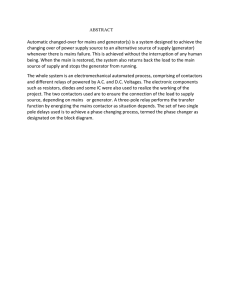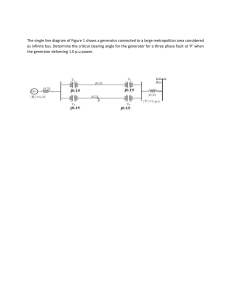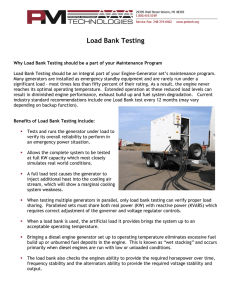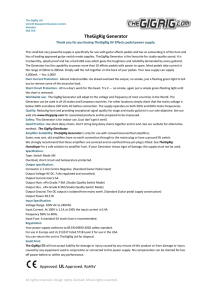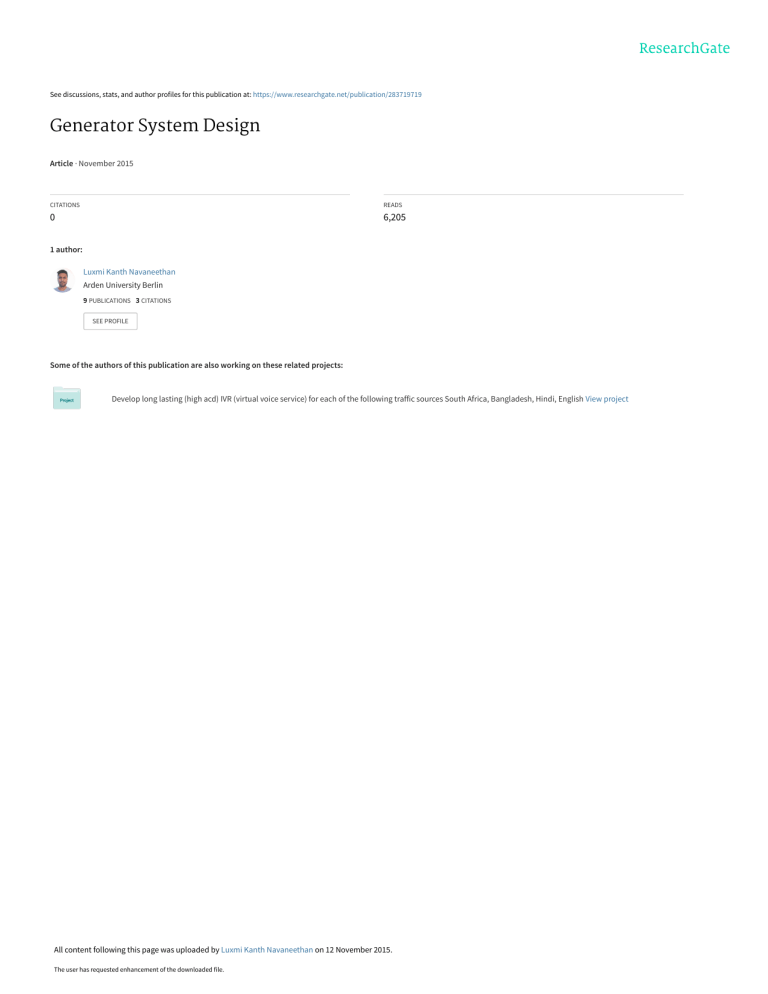
See discussions, stats, and author profiles for this publication at: https://www.researchgate.net/publication/283719719 Generator System Design Article · November 2015 CITATIONS READS 0 6,205 1 author: Luxmi Kanth Navaneethan Arden University Berlin 9 PUBLICATIONS 3 CITATIONS SEE PROFILE Some of the authors of this publication are also working on these related projects: Develop long lasting (high acd) IVR (virtual voice service) for each of the following traffic sources South Africa, Bangladesh, Hindi, English View project All content following this page was uploaded by Luxmi Kanth Navaneethan on 12 November 2015. The user has requested enhancement of the downloaded file. Generator System Design Contents 1. Introduction 2. General Design Considerations 3. Loads 4. Controls and Operation 5. Cooling System 6. Fuel and Lubricating System 7. Starting Batteries and Charger 1. Introduction This guide outlines the general design requirements that should be considered for generator systems including gas turbine or diesel sets, and base load or standby operation. It does not outline the requirements for Combined Heat & Power installations. 2. General Design Considerations 2.1. Where it is deemed necessary for a building/facility to be provided with standby generation, the design and installation should be efficient, cost effective and suitable for the operations undertaken within the building. The selection should be based on the following general criteria: • for loads in excess of 1.5 MVA considerations should be given to generation at HV • For sites with multiple buildings consideration should be given to locating generators either at each building or centrally and distributing to each building. 1 • Base load generation should be considered where: - o For Greenfield sites the mains electrical supply is either unavailable or uneconomic to install o Additional supply security is required o Mains supply is of poor quality o Base load is high enabling generators to run efficiently 2.2. The selection of either diesel or gas turbines should be considered with respect to: • Size of load • Availability of fuel • Required run-up time • Load steps • Required resilience of supply and redundancy of plant/equipment 2.3. Consideration should be given to the location of generators with regard to: • Locality to essential switch panel • Essential circuit’s voltage drop and earth fault loop impedances • Exhaust route and discharge point • Fuel supplies • Cooling air supply and extract • Effective security of the installation can be provided • Effects on ambient noise • Installation constraints • Future maintenance and generator removal 2.4. Consideration should be given to the environment and operating conditions i.e.: • Ambient temperature • Humidity • Altitude 2 2.5. The system must be arranged for safe operation under normal and maintenance operations. 2.6. The output from the generator should generally comply with the following tolerances: • Voltage tolerance (steady state): + 2.5% • Frequency tolerance (steady state): + 1% • Voltage output should be sinusoidal with no more than 2.5% total harmonic content. 2.7. Consideration should be given to the transient output voltage and frequency limits and tolerances with respect to the type of load supplied 3. Loads 3.1. The generator should be suitably rated with regard to: • Non-linear loads including UPS, variable speed controllers, PC’s, discharge lighting, etc. • Load acceptance – minimum 60% load step from a cold start • Voltage drop with regard to motor starting currents and the effect on other connected loads • Ambient conditions • Efficiency of generator operation • Spare capacity for future expansion 4. Controls and Operation 4.1. Consideration should be given to the generator control philosophy, e.g.: • Method of sensing mains failure and restoration • Mains failure/restoration control philosophy, i.e.: o Automatic start on mains failure; Automatic return on mains restoration. o Automatic start on mains failure; Manual return on mains restoration. • Interlocking to prevent paralleling of supplies • Provision of volt-free contacts to give generator status and alarm signals 3 4.2. Where generator sets are run in parallel consideration should be given to the following: • The preferred control philosophy is for the duty set to start and accept load (a load step controller may be required to prevent overloading). The standby set will then start and synchronizes with the duty set and accept the remaining load. • Where it is not possible to achieve the above, both sets should start concurrently, synchronizes and then accept load. • Circulating currents should be eliminated, e.g. by ensuring only one generator neutral is earthed. • Automatic synchronizing should be provided. • Automatic load sharing should be provided. 4.3. Where generator sets are run in parallel with the mains, consideration should be given to: • Requirements of the appropriate Supply Authority. • Automatic synchronizing should be provided initiated by a manual/automatic signal as appropriate to the project. • Means should be provided to trip the generator in the event of a mains failure whilst in parallel with the generator. The preferred method is by use of a ROCOF relay. (Rate of Change of Frequency) 4.4. Power factor correction capacitors, where provided, should be switched out of circuit prior to the generator starting. 4.5. Either the generator vendor or the switch panel vendor should be designated to take the lead to ensure that signals are correctly interfaced. 4.6. Where UPS loads are supplied via a generator suitable time delays, as necessary, should be incorporated into the changeover circuit to allow the UPS to synchronize with the mains supply upon mains restoration. 4 4.7. A generator control panel should be provided to house all control and protection equipment. The following control switches should be provided: • Water-jacket immersion heater on/off. • Battery charger on/off. • Selector switches providing "manual start/off/automatic start" positions. • “Return to Mains” key switch may be required • Emergency stop pushbutton. 4.8. The following instruments should be provided:• Voltmeter with phase & line voltage selector switch. • Ammeter with phase & neutral selector switch. • Frequency meter. • KW Meter. • Hours-run recorder. • Battery Voltmeter. • Charging current ammeter • Synchroscope for parallel operation (when applicable) 4.9. The generator must be protected against faults, the selection being based upon generator rating and whether sets are standalone or run in parallel. Upon occurrence of any of the typical faults listed below the engine should automatically shutdown, individual fault indication be provided on the control panel together with audible alarm, manual reset and common fault volt-free contacts provided for remote indication. • Over current • Voltage controlled over current • Unrestricted earth fault • Restricted earth fault 5 • Over-voltage • Over speed • Reverse Power • Under-voltage • Over-temperature • Fail to Start Lockout. • Fire Shutdown. • Emergency Stop. • Low oil Pressure. • Low Coolant Level. 4.10. Upon occurrence of any of the typical alarms listed below individual alarm indication should be provided on the control panel together with audible alarm, automatic reset on correction of the fault, and common alarm volt-free contacts provided for remote indication. • High Fuel Level (from local feeder or day tank). • Low Fuel Level (from local feeder or day tank). • Engine battery charger fails (0-5 minute adjustable time delay). • Battery Output Voltage Low. • Inlet louver motor trip. • Outlet louver motor trip. 4.11. Status indication of the following conditions should also be provided: • Mains supply available. • Alternator circuit breaker-open-closed. • Systems normal. 6 5. Cooling System 5.1. The engine should be provided with an efficient radiator cooling system capable of meeting the water and lubricating oil requirements of the engine on continuous full load and for one hour at 10% overload under the local climatic conditions for standby sets. 5.2. Thermostatically controlled engine water jacket immersion heaters should be provided to prevent freezing and to aid starting. 6. Fuel and Lubricating System 6.1. All fuel and lubricating oils used should be in accordance with the Manufacturer's recommendations. 6.2. A daily service tank with sufficient capacity (to allow for reasonable filling during full load running) should be located near the diesel alternator. The location should be suitable for easy access for re-filling. Where required bulk fuel storage should be arranged at a central point, or points. The tanks should be provided with a bund to take 110% of the tank capacity in overflow. Consideration should be given to frost protection of the tank and pipelines and the provision of a sunscreen around the tanks. Tanks should not be installed underground. 6.3. The tanks should be provided with fuel level gauges. 6.4. The engine should be totally enclosed with forced lubrication from an integral mechanical engine driven pump. Manual lubrication of any part of the engine should not be required. The capacity of the lubricating oil system should be sufficient to allow the engine to run for a minimum of 24 hours at any load, without the need for replenishment. 7. Starting Batteries and Charger 7.1. The engine should be started by an electric starter operating from batteries providing an output of 24 volts and of sufficient capacity to start, or attempt to start the engine on the basis of three 30 second cranks with 10 seconds rest between each attempt to start. 7 View publication stats
